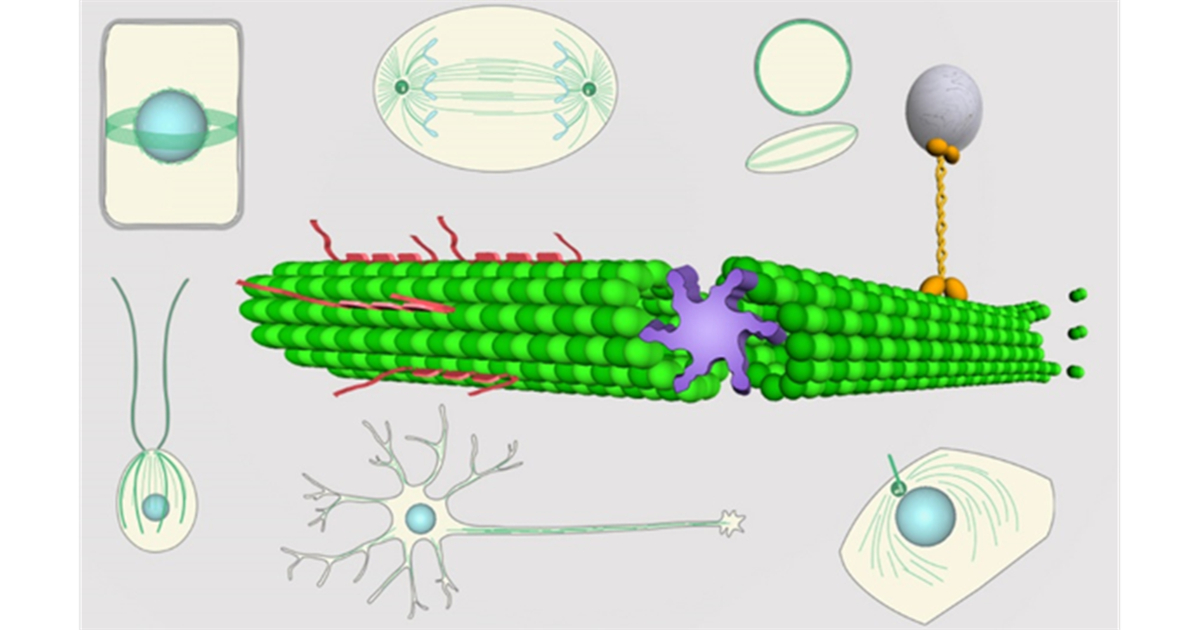Microtubules: Organization, Dynamics and Functions
A special issue of Cells (ISSN 2073-4409). This special issue belongs to the section "Intracellular and Plasma Membranes".
Deadline for manuscript submissions: closed (30 December 2023) | Viewed by 3097

Special Issue Editors
Interests: cytoskeleton; flagella; cilia; centrosome; centriole; basal body; microtubules; tubulin posttranslational modifications
Interests: tubulin; non-microtubular tubulins; tubulin posttranslational modifications; basal body; centriole; cilia; flagella
Special Issue Information
Dear Colleagues,
In different cell types, or even within specific cell regions, the organization of microtubules can have different levels of sophistication. Microtubules can vary from a network of cytoplasmic microtubules or bundles of filaments supporting intracellular transport and cell shape to complex structures enabling cell division or serving as scaffolds of the centriole, basal body, and cilium. The formation, maintenance, and remodeling of such diverse microtubular assemblies is strictly regulated and involves numerous factors, including tubulin post translational modifications and microtubule-interacting proteins. In recent years, a number of excellent studies significantly improved our understanding of the structure, dynamics and function of microtubules.
This Special Issue of Cells intends to gather publications that present cutting-edge research in the field. We call for manuscripts, either in the form of original research articles, short communications, or reviews, which are related to the following topics: the organization and regulation of microtubular cytoskeleton in organisms from various eukaryotic clades (animals, plants, fungi, protists); intracellular transport and motor proteins; the role of microtubules in cell motility, division, senescence and carcinogenesis; and intrinsic (tubulin isotypes, posttranslational modifications, microtubule interacting proteins) and extrinsic factors (drugs) affecting microtubule dynamics, including potential anti-cancer agents.
Dr. Dorota Włoga
Dr. Ewa Joachimiak
Guest Editors
Manuscript Submission Information
Manuscripts should be submitted online at www.mdpi.com by registering and logging in to this website. Once you are registered, click here to go to the submission form. Manuscripts can be submitted until the deadline. All submissions that pass pre-check are peer-reviewed. Accepted papers will be published continuously in the journal (as soon as accepted) and will be listed together on the special issue website. Research articles, review articles as well as short communications are invited. For planned papers, a title and short abstract (about 100 words) can be sent to the Editorial Office for announcement on this website.
Submitted manuscripts should not have been published previously, nor be under consideration for publication elsewhere (except conference proceedings papers). All manuscripts are thoroughly refereed through a single-blind peer-review process. A guide for authors and other relevant information for submission of manuscripts is available on the Instructions for Authors page. Cells is an international peer-reviewed open access semimonthly journal published by MDPI.
Please visit the Instructions for Authors page before submitting a manuscript. The Article Processing Charge (APC) for publication in this open access journal is 2700 CHF (Swiss Francs). Submitted papers should be well formatted and use good English. Authors may use MDPI's English editing service prior to publication or during author revisions.
Keywords
- tubulin
- microtubule
- microtubule organization
- tubulin posttranslational modifications
- microtubule interacting proteins
- mitotic and meiotic spindle
- centriole
- basal body
- cilium
- microtubules in cancer
- anti-cancer drugs
Benefits of Publishing in a Special Issue
- Ease of navigation: Grouping papers by topic helps scholars navigate broad scope journals more efficiently.
- Greater discoverability: Special Issues support the reach and impact of scientific research. Articles in Special Issues are more discoverable and cited more frequently.
- Expansion of research network: Special Issues facilitate connections among authors, fostering scientific collaborations.
- External promotion: Articles in Special Issues are often promoted through the journal's social media, increasing their visibility.
- e-Book format: Special Issues with more than 10 articles can be published as dedicated e-books, ensuring wide and rapid dissemination.
Further information on MDPI's Special Issue policies can be found here.







